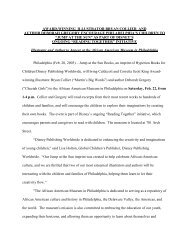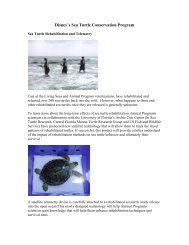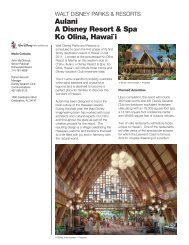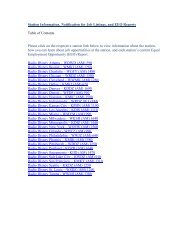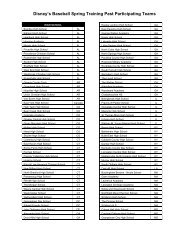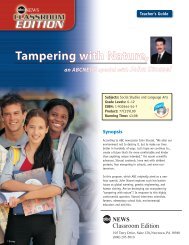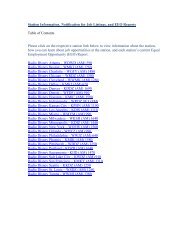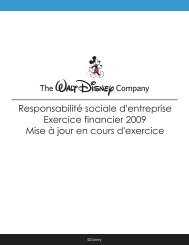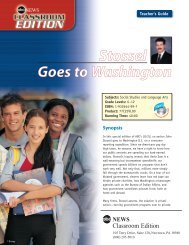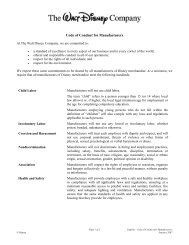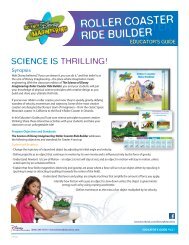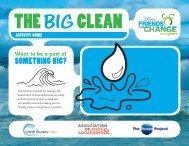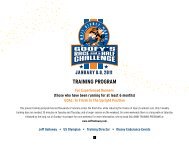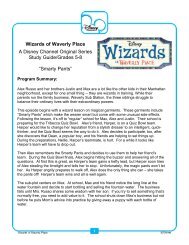The Proud Family: âI Had a Dreamâ A Disney Channel Episode for ...
The Proud Family: âI Had a Dreamâ A Disney Channel Episode for ...
The Proud Family: âI Had a Dreamâ A Disney Channel Episode for ...
You also want an ePaper? Increase the reach of your titles
YUMPU automatically turns print PDFs into web optimized ePapers that Google loves.
<strong>The</strong> <strong>Proud</strong> <strong>Family</strong>: “I <strong>Had</strong> a Dream”A <strong>Disney</strong> <strong>Channel</strong> <strong>Episode</strong> <strong>for</strong> Cable in the ClassroomAges 8-13Program Synopsis:Penny and her classmates are unapologetically bored as they face the arrival of yet another “BlackHistory Month.” Although their teacher, Mr. Webb, warns them that they “won’t have a future” ifthey “don’t understand their past,” they are unimpressed. After class, annoyed by their assignmentand absorbed in their complaining, they are oblivious to the janitor working in the hallway. Blithelywalking through his freshly cleaned floor, they run from his scolding, laughing. Penny slips, however,and falls, not only onto the floor but also into a dream.On what appears to be the next day, strange things happen at school. Why is Penny’s black teachernow a janitor? Why is everyone horrified when Penny speaks to her friend, Zoey, a white girl? Whyare all the black students sitting in the back of the class, using old, tattered textbooks? And why doesthe calendar say it is 1955?Penny’s incredulity and her insistent questioning cause her to get sent home from school. Through anact of kindness towards Zoey, the two girls become close, talking openly about racial segregation.When they return to school, they sit together, refusing to separate. One by one their classmates jointhem, marching hand in hand out of school. Met by protesters and police, Penny seizes the moment,reciting portions of Dr. Martin Luther King’s stirring “I Have a Dream” speech. Waking from herdream, Penny tells her friends and family how different things would be today if no one had fought<strong>for</strong> Civil Rights. Having seen the past, Penny now appreciates its importance, and can at lastunderstand her teacher’s admonition.Objectives:<strong>The</strong> student will:• Understand the concept of racial segregation and learn its impact on day-to-day life in the 1950sand 1960s.• Be motivated to investigate the Civil Rights Movement in the United States.• Hear the words of Dr. Martin Luther King’s stirring “I Have a Dream” speech and learn moreabout his life and accomplishments.Preview Questions:• What is segregation?• What is integration?• What is discrimination?• In the United States, is it legal to discriminate against someone on the basis of their race? Was itever legal to do so?
• In the United States, is it legal to have schools, restaurants, or other public facilities set aside <strong>for</strong>people of a certain race? Was it ever legal to do so?• How would you feel if you were told not to talk to someone or enjoy their company simplybecause you were not of the same racial background?Post-Viewing Questions:• Why were Penny and her friends so annoyed about Black History Month?• Why did their teacher, Mr. Webb, think it was so important? [Because “if you don’t understandyour past, you won’t have a future.”]• What aspects of their lives did Penny and her friends take <strong>for</strong> granted?• In what important ways was the 1955 <strong>Proud</strong> family different from the modern-day version?• What types of racial discrimination did Penny experience in her 1950s dream sequence?• What famous civil rights leader was Penny quoting when she made her speech?• Where and when did Martin Luther King, Jr., actually deliver his “I Have a Dream” speech[At the March on Washington in August 1963.]Vocabulary:• What were some of the conflicts you observed in the story?• What do you think are some of Vicky’s inner conflicts?• How does Vicky resolve her inner conflicts?• Who was your favorite character in the story—and why?• How much of the story do you think was fantasy? How much of it could have been fact?• Several of the characters changed during the story. Who do you think changed most?Be specific in describing the changes you observed.Vocabulary:cease and desistcoloredculturally biasedinjusticeinsolenceintegrationsegregationUse a dictionary to define each word or term above as it was used in the program.On a piece of graph paper, arrange the words in a crossword puzzle. Assign numbers to each entryand create a list of clues.
SOCIAL STUDIESActivity #1: Martin Luther King, Jr.Key Questions: Who was Dr. Martin Luther King, Jr.? Why are his accomplishments important to us?Brainstorm: Ask students what they know about Martin Luther King, Jr. On the board, write downstudent answers to the following questions:• Who was Dr. King?• What is he most famous <strong>for</strong>?• What did he believe in?• What were his goals?• How did he try to accomplish those goals?Discuss student answers, emphasizing Dr. King’s contributions to the Civil Rights movement inAmerica. Explain that he believed strongly in nonviolent protest to achieve goals of equalopportunity in jobs, housing, and education. That he organized many protests and marches.Provide books and Internet access (see Resources section, below) so students can research the lifeand accomplishments of Dr. King. Working individually or in teams, students should find out thefollowing:• Date and place of birth.• Major accomplishments.• At least five interesting facts about his life.• One example of his courage.• One example of how his actions have an effect on us today.•Ashort quote from one of Dr. King’s books or speeches.Have students choose one of the following ways to showcase what they have learned:• Make an illustrated timeline of Dr. King’s life.• Role-play an interview with Dr. King.• Choose an event or major accomplishment from Dr. King’s life and write a newspaper articleabout it.•Write a letter to Dr. King from the point of view of Penny <strong>Proud</strong>, thanking him <strong>for</strong> working toend segregation and acknowledging specific contributions.• Create a series of postage stamps honoring Dr. King, each depicting an important event or aspectof his life.EXTENSION: Have students read biographies of other civil rights, leaders, activists, or role models,such as Rosa Parks, Jackie Robinson, Ruby Bridges, Thurgood Marshall, or others.
Activity #2: Straight to the Source: Dr. King’s “I Have a Dream” SpeechKey Questions: Where and when did Martin Luther King, Jr., deliver his famous “I Have a Dream”speech? What important concepts did he communicate?In this episode of <strong>The</strong> <strong>Proud</strong> <strong>Family</strong>, Penny quotes from Dr. Martin Luther King, Jr., using thestirring language and imagery of his most famous civil rights speech.Locate the complete text of Dr. King’s "I Have a Dream" speech, either in a book, such as:Words That Built a Nation: A Young Person’s Collection of Historic American Documents, byMarilyn Miller (New York: Scholastic, 2000).or online at:http://www.wmich.edu/politics/mlk/dream.htmlor:http://www.usconstitution.net/dream.htmlPrint out or photocopy the speech. Give each student a copy. Explain that Dr. King delivered thespeech on August 23, 1963, from the steps of the Lincoln Memorial in Washington, D.C. King hadhelped organize a huge, nonviolent protest march to focus public attention on civil rights. More than250,000 people attended the event, called the March on Washington <strong>for</strong> Jobs and Freedom.As a class, focus on these three sections of the document:(1) Read the first sentence aloud: “Five score years ago, a great American, in whose symbolicshadow we stand, signed the Emancipation Proclamation.” Discuss with students:• Who is the great American King refers to?• Why does he mention President Lincoln?• What was the Emancipation Proclamation?• Did the act of freeing slaves mean that they enjoyed equal freedoms in America?(2) Read the “When will you be satisfied?” section of the speech.Have students work in teams to list the types of civil rights Dr. King refers to. For each, ask thegroup to discuss and decide whether, today, we should “be satisfied” about each example. Why orwhy not?(3) Read the section of the speech that begins “. . . I still have a dream. It is a dream deeply rooted inthe American Dream.” Continue reading through to the phrase, “. . . where little black boys andblack girls will be able to join hands with little white boys and girls and walk together as sistersand brothers.”Ask students to describe Dr. Kings dreams in their own words.Which parts of the dream have come true?Which parts do they think have not yet come true?[For a geography lesson utilizing Dr. King’s speech, see the activity below]
Activity #3: What Happened <strong>The</strong>n (1955)?Key Question: What was happening half a century ago?Grab a glimpse of life in 1955, the year Penny <strong>Proud</strong> visits in her dream/nightmare. Have students doa little research and then fill in the blanks:Back in 1955 . . .• It cost _____ cents to mail a letter.• ______________ was president of the United States.• ______________won the Academy Award <strong>for</strong> Best Picture.• Jonas Salk made a major contribution to world health with this important medical breakthrough:__________________• <strong>The</strong> __________________ beat the New York Yankees to win their first World Serieschampionship.• __________________, an African-American civil rights activist, was arrested in Montgomery,Alabama, <strong>for</strong> refusing to give up her seat on a public bus so a white man could sit down.Answers:1. 3 cents2. Dwight D. Eisenhower3. On the Waterfront4. A vaccine to protect against polio.5. Brooklyn Dodgers6. Rosa ParksInternet resource: http://www.infoplease.com/year/1955.htmlActivity 4: Timeline—Sort It OutKey Questions: When did important milestones occur in the struggle <strong>for</strong> civil rights? What was theirsignificance?In the “I Have a Dream” episode, Penny <strong>Proud</strong>’s time travels lead to a curiously scrambledchronology. She’s a 21st-century kid in a 1950s world reciting her own version of a speech MartinLuther King, Jr., actually delivered in 1963. Help students sort out—and understand--the correctsequence of events by having them create a Civil Rights timeline.Start with these key civil rights events:1896 Plessy v. Ferguson: U.S. Supreme Court upholds the concept of "separate but equal"public facilities.1947 Freedom Riders
1954 Brown v. Topeka, Kansas, Board of Education: In a landmark case, the U.S.Supreme Court ruled that racial segregation in public schools was unconstitutional.1955 Rosa Parks is arrested <strong>for</strong> refusing to sit in the back of a city bus in Montgomery,Alabama.1955-56 Montgomery Bus Boycott: Blacks boycott all city buses to protest Jim Crow laws.1957 <strong>The</strong> Civil Rights Act of 1957 is passed, establishing the Commission on CivilRights.<strong>The</strong> “Little Rock Nine” integrate a previously all-white high school.1961 “Sit In” at a Woolworth’s lunch counter in Greensboro, S.C.1963 Civil rights marchers in Birmingham, Alabama, are met by police with high-pressurefire hoses and attack dogs.250,000 people attend the “March on Washington,” where Martin Luther King, Jr.,delivers his famous “I Have a Dream” speech1964 Civil Rights Act of 1964 is passed, banning discrimination and funding schooldesegregation.1965 Voting Rights Act of 1965 is passed. It banned discriminatory voting registrationpractices.Assign an important civil-rights event to each student, pair of students, or small groups. Use the listprovided <strong>for</strong> suggested events, or choose others that relate to your Social Studies curriculum.Attach a length of butcher paper to the classroom wall. Choose a span of years that accommodatesthe events you have assigned, and mark off sections in five-year spans. (You may want to involvestudents in measuring and marking the timeline as a way of incorporating hands-on math skills in theactivity.) Have students locate and list their “name” of their event on the timeline.Have students research key facts about their event. On a separate sheet of paper and using completesentences, have students answer the following questions:• When did it occur? List the exact date, or a date range.• Who was involved? Provide the names, birth and death dates, and in<strong>for</strong>mation about the peoplewho were instrumental in the event.• What happened? Describe the event, document, or court ruling in detail.• What was the impact at the time? Be sure to include various points of view, if people weredivided or in disagreement about its value or importance.• How does it affect us today? Explain what the long-term effects of the event have been. Howwould things be different if that milestone had never occurred?After they have done their research and answered the questions, have students summarize their eventin the <strong>for</strong>m of a newspaper headline, with a title, subtitle, and dateline. Instruct students to write theirheadlines neatly on a 3-by-5-inch index card. On a separate index card, students can provide an
illustration. Attach the cards in the appropriate place along the classroom timeline, using colored yarnand thumbtacks to indicate the precise location, if necessary.Encourage students to add to the timeline additional in<strong>for</strong>mation and dates gleaned from theirresearch. For example, they could add the birth dates of important figures, the dates when civil-rightsorganizations were founded, and so on.Internet resources:Timeline of the Civil Rights Movementhttp://www.wmich.edu/politics/mlk/tm.htmlActivity #5: That Was <strong>The</strong>n, This Is NowKey Question: What can we learn about race relations in the 1940s, 1950s, and 1960s from peoplewho were students at the time?Let students gather first-hand accounts of race relations in mid-century America by having them talkto people of older generations. By conducting a short, focused interview, students can learn keydetails and compare their in<strong>for</strong>mation with one another. Photocopy and distribute Handout #1 tostudents. Have students choose an adult to interview. <strong>The</strong> person must be at at least 55 years old andmust have spent his or her childhood in the United States. <strong>The</strong> interviewee should be a friend,neighbor, or relative who the student is com<strong>for</strong>table with. Students can conduct the interview inperson or over the phone.After students have conducted their interviews and filled in their logs, discuss the results as a class.Where did the people who were interviewed grow up? (Locate on a map or globe). Did theirexperiences vary geographically? What were the similarities and differences among variousresponses?[For a related creative writing activity, see Language Arts, below]Activity #6: Picturing Segregation / Picturing IntegrationKey Questions: What is segregation? What is racial integration? How do they affect us in everydaylife?Discuss with students the terms “segregation” and “integration” as those words relate to the civilrights movement in America. Read the dictionary definitions and facilitate a class discussion in whichstudents provide examples of racial segregation and integration.Provide magazines, scissors, glue, and construction paper and instruct students to each create twocollages: one showing people engaged in everyday activities, but separated along racial lines; theother showing people of variety of ethnic and racial backgrounds working, studying, and enjoyingleisure activities together. Display the finished collages in the classroom.
LANGUAGE ARTSActivity #1: Eyewitness to HistoryKey Question: What would it have been like to watch history in the making?After learning about a civil rights leader such as Martin Luther King, Jr., Rosa Parks, Ruby Bridges,or others (see Social Studies Activity #1, above), have each student choose one important event inthat person’s life and write about it from the point of view of an anonymous eyewitness, a bystander,or some other participant in the event, either real or fictional.Examples:• MLK’s “I Have a Dream Speech,” from the point of view of a college student lost in the crowd of250,000 people.• Rosa Parks’ refusal to “move to the back” of the bus, from the point of view of the bus driver or awhite passenger.• Ruby Bridges’ first day of school, from the point of view of a National Guardsman sent to protecther.Students work in pairs to brainstorm what the event would have been like <strong>for</strong> the bystander. Next,one student of each pair writes a short paragraph describing the event. <strong>The</strong> other student then addsdetails to the description. With one person acting as the famous subject and the other role-playing theeyewitness, students role-play to elicit even more details, quotes, about the event. Finally, studentscollaborate on a finished piece in the <strong>for</strong>m of a newspaper article.Activity #2: <strong>The</strong> True Story of . . .Key Question: What are the most interesting aspects of my interview with an “everyday American”?Build on the interview conducted as part of Social Studies Activity #5, above. Have students reviewthe in<strong>for</strong>mation they gathered from the interview (see Handout #1). <strong>The</strong>n have them write a shortstory, newspaper article, or first-person account incorporating the real-life experiences of the personthey interviewed.GEOGRAPHYActivity #1: A Range of MountainsKey Question: What mountain ranges and states are mentioned by Dr. King in his “I Have a Dream”speech, and where are they located?Martin Luther King, Jr., used imagery that encompassed the entire United States in his stirring “IHave a Dream Speech.” First King quoted the patriotic song My Country ‘Tis of <strong>The</strong>e: “my country'tis of thee; sweet land of liberty; of thee I sing; land where my fathers died, land of the pilgrim'spride; from every mountain side, let freedom ring” <strong>The</strong>n he echoed and expanded on those lyrics withthese lines:
And if America is to be a great nation, this must become true.So let freedom ring from the prodigious hilltops of New Hampshire!Let freedom ring from the mighty mountains of New York!Let freedom ring from the heightening Alleghenies of Pennsylvania!Let freedom ring from the snow-capped Rockies of Colorado!Let freedom ring from the curvaceous peaks of Cali<strong>for</strong>nia!But not only that.Let freedom ring from Stone Mountain of Georgia!Let freedom ring from Lookout Mountain of Tennessee!Let freedom ring from every hill and molehill of Mississippi!From every mountainside, let freedom ring!For each of the phrases above, have students (1) identify the mountain range, (2) identify the stateand its capitol, and (3) locate the mountain ranges, states, and capitols on a map. If your state orregion is not mentioned, encourage students to write their own phrase to add to the list, following thestyle of those used by Dr. King.SCIENCEActivity #1: African-American ContributionsKey Question: In what ways have the achievements of African-Americans benefited the lives of allAmericans?When Penny tells her teacher and classmates about African Americans who have made valuablecontributions to science, industry, and politics, those folks from the fifties dismiss the possibility.Penny specifically mentions G. A. Morgan, Dr. Daniel Williams, and Lonnie Johnson, real-life highachieversyour students can investigate using the library, encyclopedias, classroom resources, and theInternet. Have each student choose one person to research; then have students create a drawing orcollage showcasing the inventions and medical breakthroughs of their subject.
Garrett Augustus Morgan (1877-1963)An inventor who was granted four U.S. patents in the early 1900s. His inventions, which includedhelmets and gas masks used by firefighters and the first automated traffic signal, enhanced publicsafety.Find out more about G.A. Morgan at:http://www.princeton.edu/~mcbrown/display/morgan.htmlTake a look at the patent <strong>for</strong> his traffic signal, including an illustration, at:http://www.princeton.edu/~mcbrown/display/morgan_patents.htmlDraw a picture of Morgan’s automated traffic signal (be sure to include labels). Create a collageor illustration showing what busy intersections might look like without traffic signals.Dr. Daniel Hale Williams (1856-1931)In 1893, this pioneering doctor per<strong>for</strong>med the first successful open-heart surgery.Read more about Dr. Williams at:http://www.princeton.edu/~mcbrown/display/williams.htmlhttp://www.bet.com/articles/1,,c13gb1723-2389,00.htmlhttp://www.gibbsmagazine.com/DrWilliams.htmLonnie G. Johnson (1949- )While experimenting on heat pumps, this rocket scientist who worked at NASA’s famed JetPropulsion Laboratory invented the Super Soaker®, a water gun that washed away the competition.http://mit.edu/invent/iow/johnson.htmlFind more black inventors at:http://www.bccns.com/history_inventions.htmlHANDOUT 1: INTERVIEW LOGSTUDENT:_____________________________PERSON INTERVIEWED: _______________DATE OF BIRTH: ______________________DATE OF INTERVIEW: __________RELATIONSHIP ________________PLACE OF BIRTH: ______________QUESTIONS: Where did you go to school? (Ask <strong>for</strong> the location, not the name of each school) Whatwas the approximate racial/ethnic makeup of each school?ANSWERS:
QUESTION: Did you have friends whose racial or ethnic backgrounds were different from yourown? Was that typical or unusual?__________________________________________________________________________________________________________________________________________________________________QUESTION: How would you describe the relations between various racial groups? Was thereinteraction among people from different groups? Was there tension between them?__________________________________________________________________________________________________________________________________________________________________QUESTION: Can you provide an example or story that will convey some aspect of racial/ethnicrelations in your elementary, middle, or high school?__________________________________________________________________________________________________________________________________________________________________QUESTION: In comparison with the way things are today, would you say that racial/ethnic relationschanged since you were in school? If so, in what ways have things changed? Why do you thinkchanges (if any) have occurred?__________________________________________________________________________________________________________________________________________________________________Use the back of this sheet to write additional in<strong>for</strong>mation or anecdotes]RESOURCESINTERNETNational Archives and Records Administration Milestone Documentshttp://www.ourdocuments.gov/content.php?page=milestone_documentsComplete transcripts, photographs of, and in<strong>for</strong>mation about one hundred key documents in U. S.history from 1776 to 1965, including the Emancipation Proclamation, the U.S. Supreme Courtdecision in Brown v. Board of Education, the 13th, 14th, and 14th Amendments to the Constitution.Great Civil Rights Speecheshttp://www.pbs.org/greatspeeches/teachers/foot1.htmlContains links to speeches by prominent African Americans, including Dr. Martin Luther King, Jr.African American Odyssey: <strong>The</strong> Civil Rights Erahttp://memory.loc.gov/ammem/aaohtml/exhibit/aopart9.htmlFrom Slavery to Civil Rights: A Timeline of African-American Historymemory.loc.gov/ammem/ndlpedu/features/civilrights/nonflash.html
Civil Rights Timelinehttp://seattletimes.nwsource.com/mlk/movement/Seatimeline.htmlOral histories of young Civil Rights workers:http://www.ssecinc.org/less/Fset_ls_free.htm<strong>The</strong> Martin Luther King, Jr., Papers Project at Stan<strong>for</strong>d Universityhttp://www.stan<strong>for</strong>d.edu/group/King/Biography of Martin Luther King, Jr.http://www.stan<strong>for</strong>d.edu/group/King/about_king/Dr. Martin Luther King, Jr.http://www.drmartinlutherkingjr.com/mlkbio.htmBiography, photographs, and audio recordings of speechesBOOKS<strong>The</strong> Civil Rights Movement in America From 1865 To the Present, by Patricia and FredrickMicKissack (Chicago: Children's Press, 1987).<strong>The</strong> Day Martin Luther King, Jr. Was Shot: A Photo History of the Civil Rights Movement, byJames Haskins (New York: Scholastic, 1992).. . . If You Lived at the Time of Martin Luther King, by Ellen Levine, illus. by Anna Rich (NewYork: Scholastic, 1994).I Have a Dream: <strong>The</strong> Story of Dr. Martin Luther King, by Margaret Davidson (New York:Scholastic, 1986).<strong>The</strong> March on Washington: Journey to Freedom, by L. S. Summer (Childs World, 2001)Martin Luther King, Jr., and the March Toward Freedom, by R. Hakim (Brookfield, Ct.: MillbrookPress, 1991).Martin Luther King, Jr.: Man of Peace, by Patricia and Fredrick MicKissack (Hillside, NJ: Enslow,1991).Martin's Big Words, by Doreen Rappaport, illus. by Bryan Collier (New York: Hyperion/Jump atthe Sun, 2001).<strong>The</strong> New York Public Library Amazing African American History, by Diane Patrick (New York:Wiley, 1998).White Socks Only, by Evelyn Coledman, illus. by Tyrone Geter (Martin Grove, Ill.: A. Whitman,1996).Words That Built a Nation: A Young Person’s Collection of Historic American Documents, byMarilyn Miller (New York: Scholastic, 2000).



